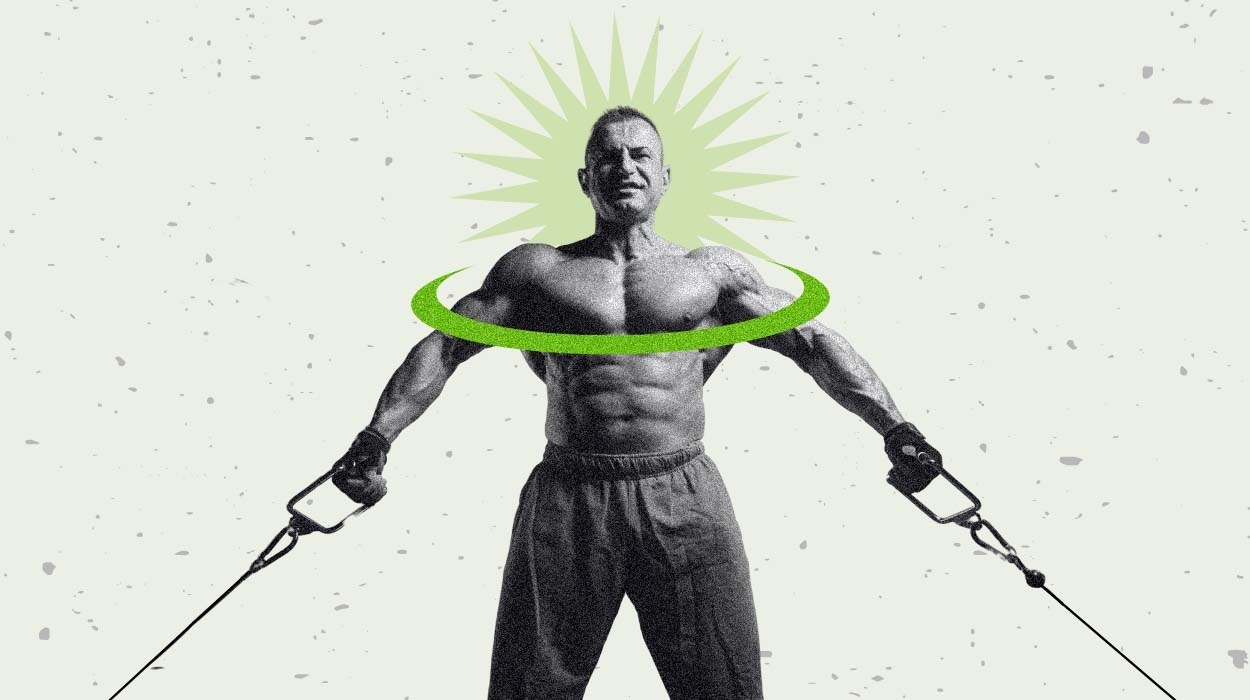
With dumbbells and barbells getting all the attention, the cable machine is the unspoken hero in the gym. This unique piece of gym equipment brings many benefits that cannot be replicated with any other piece of equipment. This is especially true when training the chest muscles.
The muscles of the chest can move the arms through a wide range of movement patterns, and a well-rounded chest workout will work the arms through a diverse range of those patterns. While we love the barbells and dumbbells, they can only apply resistance on one plane, straight down.
Therefore, if you want to optimize your training for a more effective chest workout routine, the cable machine is imperative to include. This article is going to discuss what we think are the most effective exercises to use in your next cable chest workout.
Best Chest Cable Exercises
Using the cable machine is a highly effective method to effectively train your chest muscles. This is due to its design that allows you to hit the muscle from multiple angles as well as delivering constant tension. Here are eight cable chest exercises to use in your next chest workout:
- Standing Cable Decline Press.
- Lying Cable Bench Press.
- Unilateral Standing Cable Chest Press.
- Standing Cable Crossover Fly.
- Standing Decline Cable Fly.
- Cable Incline Bench Press.
- Lying Incline Cable Fly.
- Standing Incline Cable Fly.
Cable Chest Workout: Best Exercises For The Pec Development
Below we review the eight best cable chest exercises. These exercises have been separated into two groups – lower and upper chest. Technically your chest includes one major muscle, the pectoralis major,[1] but the pectoralis contains two heads originating at your clavicle (upper chest) and sternocostal angle (lower head).
Your lower chest makes up a much larger portion of your chest and comprises your entire chest below your clavicle. The remaining portion makes up your upper chest. It is challenging to isolate the two origins of the pectoralis major separately, however, studies show they do activate[2] differently depending on the exercise used.
Lower Chest Workout With Cables
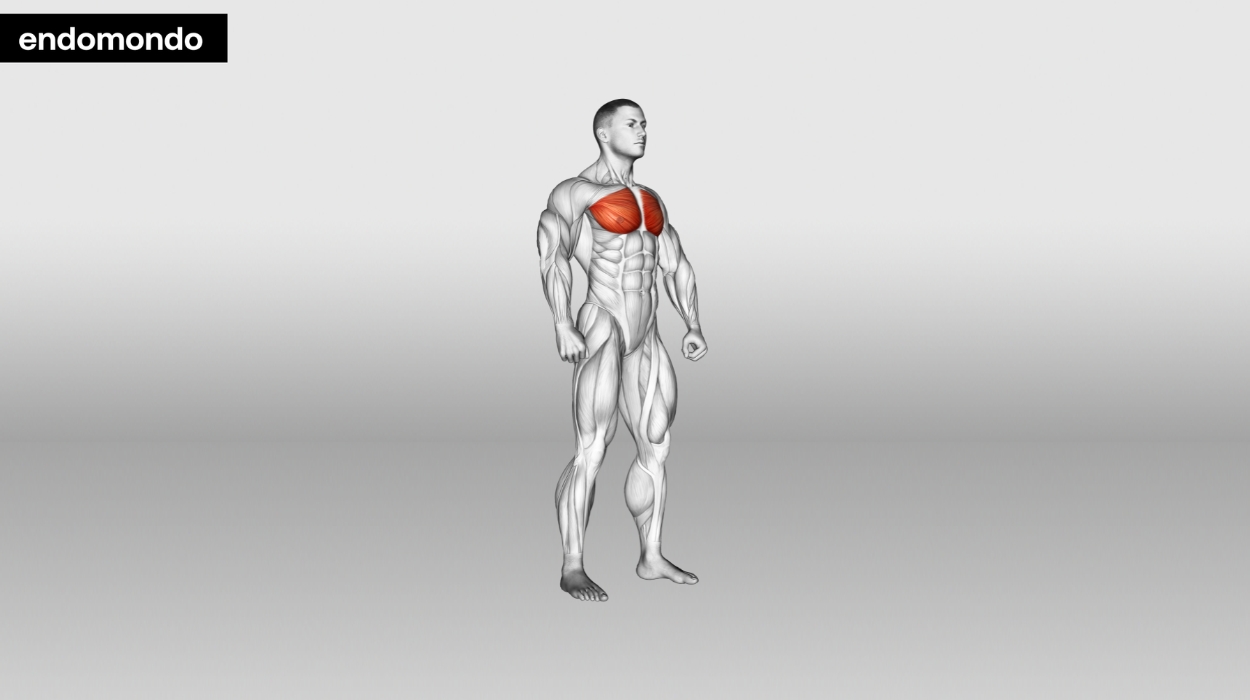
As your lower chest muscles make up the bulk of your chest, you will want to prioritize the following exercises to achieve the largest gains. This targeted routine utilizes cable machines to sculpt and strengthen the lower portion of your pectoral muscles, helping you achieve a well-rounded chest, as well as enhance definition and balance.
Standing Cable Decline Press
The standing cable decline press is a great cable exercise to target your lower chest. This exercise primarily targets the lower and mid-pectoral muscles, making it a valuable addition to any cable chest workout routine. The free weight equivalent of this exercise would be the decline bench press as both of these exercises include pressing the load towards your lower body.
By performing the standing cable decline press, you emphasize the development of the lower chest muscles, helping to create a well-defined and balanced chest. It also engages your front deltoids and triceps, contributing to upper body strength and overall chest development.
One of the key benefits of this exercise is the ability to isolate and target the lower chest region, which can be challenging with other chest exercises. It offers a unique angle of resistance, enhancing muscle engagement and promoting muscle growth.
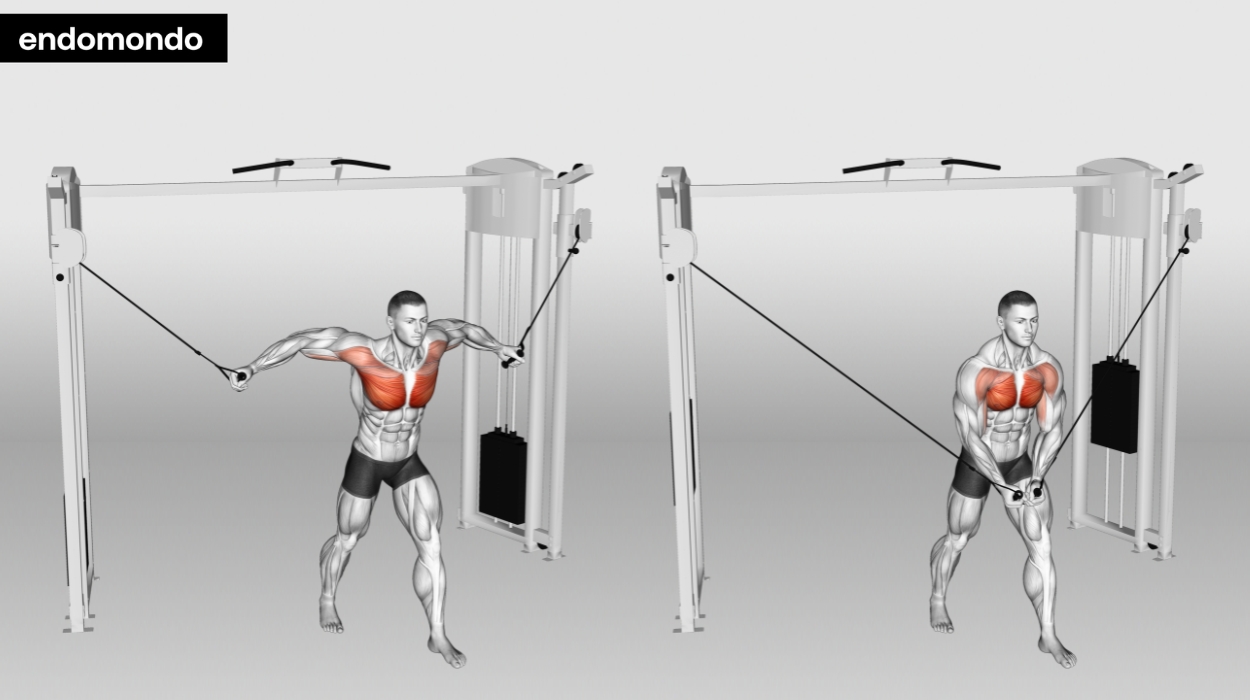
How to do:
- Position yourself between both cables facing outward with a staggered stance.
- Draw back your elbow bringing flexion to the elbow.
- Push the weight out in front of your body, ending at stomach level.
Tips:
- Keep your core engaged and maintain a stable stance to prevent excessive swaying while performing the exercise.
- Start with an appropriate weight that allows you to maintain proper form and gradually increase it as you become more comfortable with the movement.
- Focus on controlled, slow repetitions to maximize muscle engagement and reduce the risk of injury.
Optimal Sets and Reps: 3 sets of 10-12 reps.
Lying Cable Bench Press
The lying cable bench press is a powerful chest exercise that targets the pectoral muscles, making it a fantastic addition to a cable chest workout routine. This exercise works the entire chest area, including the upper, middle, and lower chest, resulting in a well-rounded and defined chest. You engage your chest muscles effectively while also recruiting the front deltoids and triceps.
The cable bench press is performed very similarly to the barbell bench press, except that it is performed on cables. You can use an adjustable bench but we recommend finding a flat bench as it is easier to move.
This exercise helps maintain tension on the chest muscles throughout the exercise, helping to stimulate muscle growth and improve chest strength and endurance. Incorporating this exercise into your cable chest workout can lead to a more sculpted and powerful chest, enhancing your upper body aesthetics and functional strength.
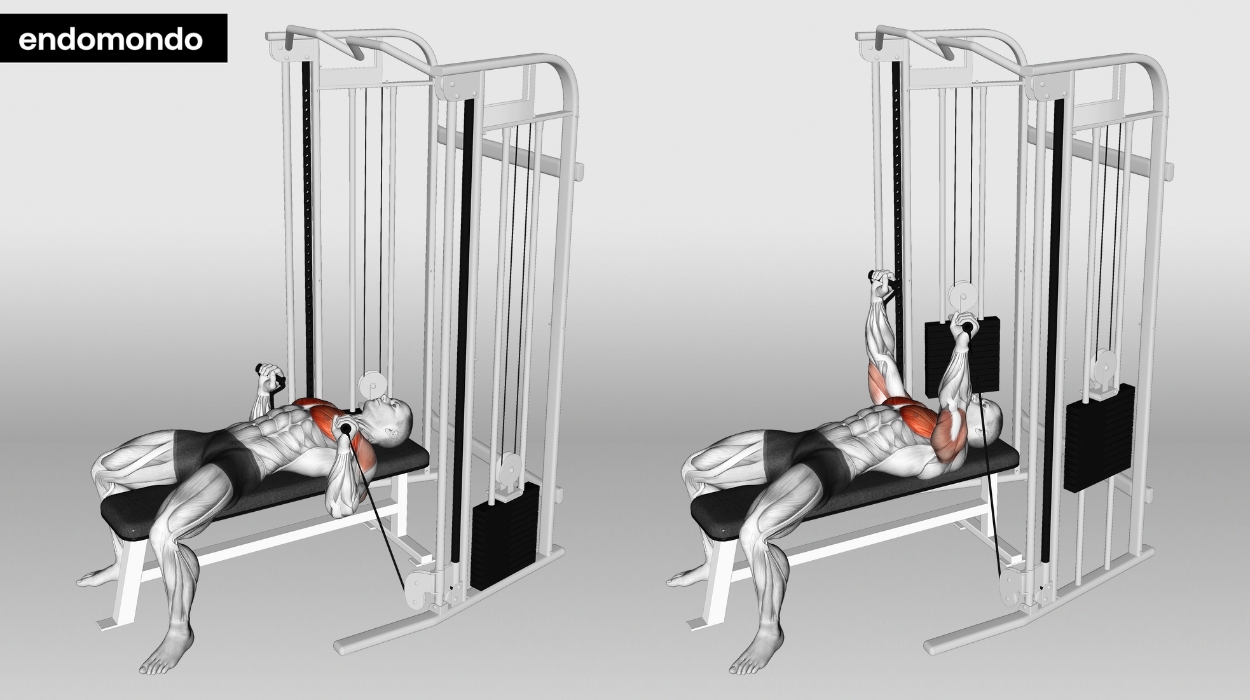
How to do:
- Place your bench between both pulleys and lay flat on the bench with the handles at chest level.
- To get into the starting position, pull the handles inward.
- Once your hands reach your upper arms, press upward.
This dual action causes the force to be directed downward and out resulting in more muscle activation. You can also include the lying cable bench press in your front delt workouts to better strengthen your shoulder joint.
Tips:
- Ensure your shoulder blades are retracted and your back is firmly against the bench to maintain stability and protect your shoulders during the exercise.
- Use a controlled, smooth motion to push the cables upward, focusing on squeezing your chest muscles at the top of the movement.
- Adjust the weight to challenge your chest muscles while maintaining good technique in your cable chest workout.
Optimal Sets and Reps: 3-4 sets of 8-12 reps.
Unilateral Standing Cable Chest Press
This exercise primarily works your pectoralis major muscles, which are responsible for the strength and definition of your chest. The unilateral aspect of this movement allows for balanced muscle development and can help correct any strength imbalances between the left and right sides of your chest. Additionally, it engages your deltoids and triceps, further enhancing upper body strength and aesthetics.
By incorporating unilateral standing cable chest presses into your cable chest workout routine, you can enhance your chest’s overall shape and strength while also improving muscle balance and stability. It’s an excellent exercise for anyone looking to build a well-rounded and sculpted upper body.
By incorporating the unilateral standing cable chest press into your cable chest workout routine, you can enhance your chest’s overall shape and strength while also improving muscle balance and stability. It’s an excellent exercise for anyone looking to build a well-rounded and sculpted upper body.
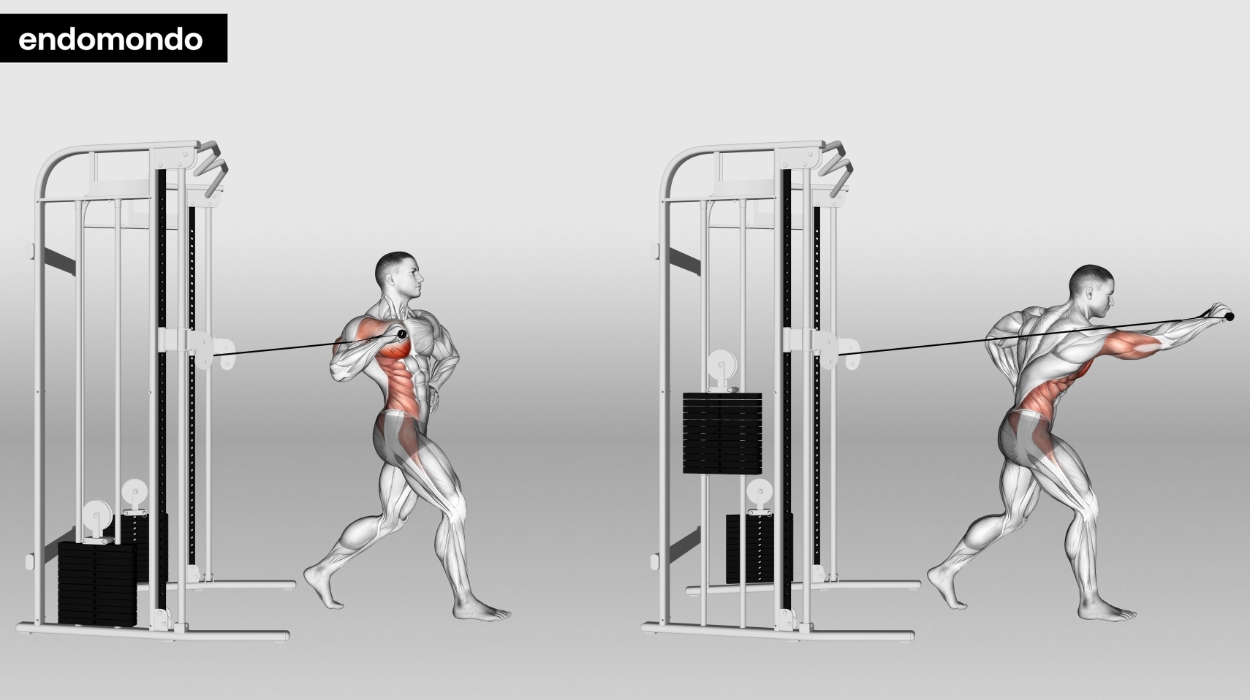
How to do:
- Set up the cable machine with a D-handle at chest height.
- Stand facing away from the machine, with feet shoulder-width apart.
- Hold the handle with one hand, palm facing down, and step forward to create tension.
- Press the handle forward until your arm is fully extended.
- Slowly return to the starting position, maintaining control and tension in the cable.
Tips:
- As you complete the exercise, add a mild rotation at the shoulders, as if you’re throwing a punch slowly and controlled to elicit more muscle activation.[3] This works through the mind-muscle connection; by thinking about the muscle action, we can achieve greater activation leading to more strength.
- Keep your chest and head up, focusing on a full range of motion to maximize muscle engagement and avoid unnecessary strain.
- Allow adequate rest between sets to optimize your performance.
Optimal Sets and Reps: 3-4 sets of 8-12 reps on each side.
Standing Cable Crossover Fly
The cable crossover is a classic cable exercise. Ultimately, it mimics the dumbbell chest fly but utilizes a larger range of motion. Due to the nature of the dumbbell chest fly, you only have resistance until your arms are directly above your chest. As you go farther, the dumbbell will be pulled down from gravity.
The cable machine allows you to pull the weight all the way across your body allowing resistance all throughout the motion. This resistance is the same throughout the movement which allows for even training on all the muscle fibers, therefore it can be more beneficial than using dumbbells and lead to greater strength training.
This exercise effectively engages and isolates the chest muscles, leading to enhanced chest development and improved muscle definition. Its versatility allows you to adjust the cable height and angle to target different parts of the chest.
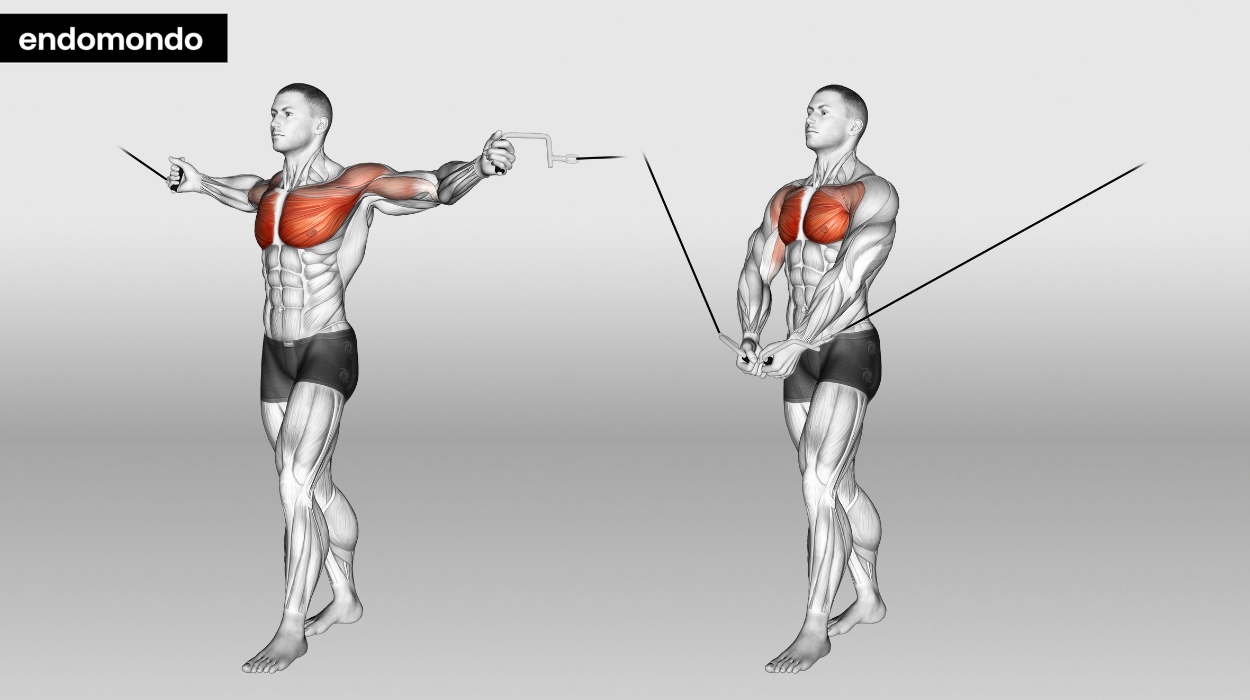
How to do:
- Adjust the pulleys on a cable machine to the highest point and attach D-handles.
- Stand in the middle, holding one handle in each hand, with arms extended and palms facing forward.
- Take a step forward with one foot to create tension in the cables.
- Keep a slight bend in your elbows and bring your arms together in front of your chest in a hugging motion.
- Slowly return to the starting position, maintaining control and feeling the stretch in your chest muscles.
Tips:
- Focus on squeezing your chest muscles together at the peak of the movement to enhance the mind-muscle connection.
- Maintain a controlled pace throughout the exercise, avoiding rapid or jerky motions, to minimize the risk of injury and ensure proper muscle engagement.
- Avoid hunching your shoulders or leaning too far forward; instead, keep an upright posture to maximize the chest workout benefits.
Optimal Sets and Reps: 3-4 sets of 10-15 reps.
Standing Decline Cable Fly
While you are standing and doing cable flys, you can adjust the pulley slightly to perform decline flys. By raising the pulley to shoulder level, you can perform a fly in a downward fashion. Studies show that this movement in chest exercises[4] places the muscle fibers in a position to see greater activation in the lower chest.
The standing decline cable fly is an excellent addition to a cable chest workout, targeting the pectoral muscles effectively. This exercise primarily works the lower and middle chest, helping to develop a well-rounded and defined chest area. By performing this exercise, you uniquely engage the chest muscles, creating tension and contraction throughout the range of motion. This exercise also involves the front deltoids and the triceps to a lesser extent, making it a comprehensive upper-body workout.
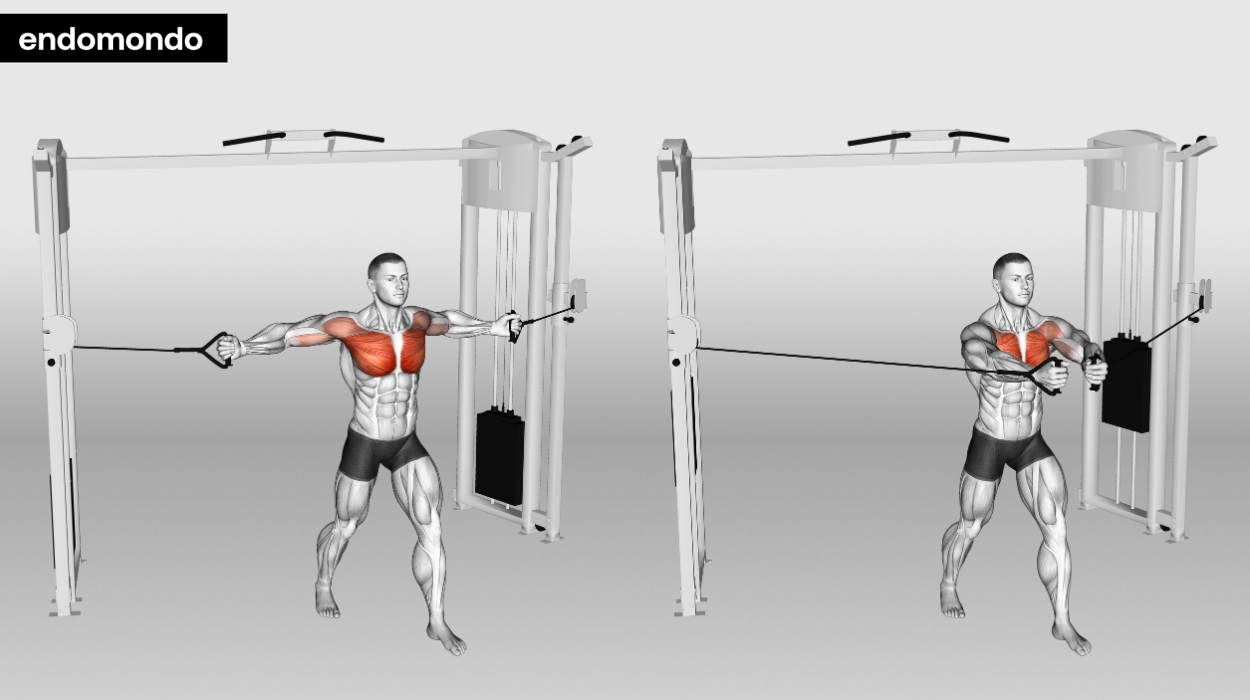
How to do:
- Set the cable machine and attach D-handle attachments to both sides.
- Stand with your back to the cable machine and hold one handle in each hand.
- Step forward slightly and lean your upper body forward at a slight angle.
- Keep a slight bend in your elbows and bring your hands together in front of your chest.
- Slowly return to the starting position, feeling a stretch in your chest, and repeat for the desired repetitions.
Tips:
- Start with an appropriate weight that allows you to maintain proper form throughout the exercise, as using too much weight can lead to compromised technique and an increased risk of injury.
- Focus on a controlled and deliberate range of motion, ensuring that your chest muscles are actively engaged during both the lifting and lowering phases of the movement.
- Keep your core tight and maintain good posture throughout the exercise to avoid excessive strain on your lower back.
Optimal Sets and Reps: 3-4 sets of 10-12 reps.
Upper Chest Workout With Cables
Effective cable chest workouts are only partially done until you have trained the upper chest. Use the below cable chest exercises to concentrate on your upper chest. This tailored routine focuses on developing the upper portion of your pectoral muscles for a well-rounded and defined chest.
Cable Incline Bench Press
The cable incline bench press is a dynamic chest exercise that primarily targets the upper chest muscles, specifically the pectoralis major. It functions in the same manner as the cable flat bench press. Your set-up for this exercise will be the same as setting up an incline press with a barbell. Therefore, you will need an incline bench, preferably one with wheels, so that you can move it easily.
This exercise helps you effectively build and define your upper chest, contributing to a more balanced and sculpted chest appearance. The constant resistance provided by the cable helps to engage the muscle fibers thoroughly, promoting strength and muscle growth. Also, this exercise recruits the front deltoids and triceps, providing a comprehensive upper-body workout. Its versatility makes it suitable for individuals at various fitness levels, as you can adjust the weight and intensity to match your goals.
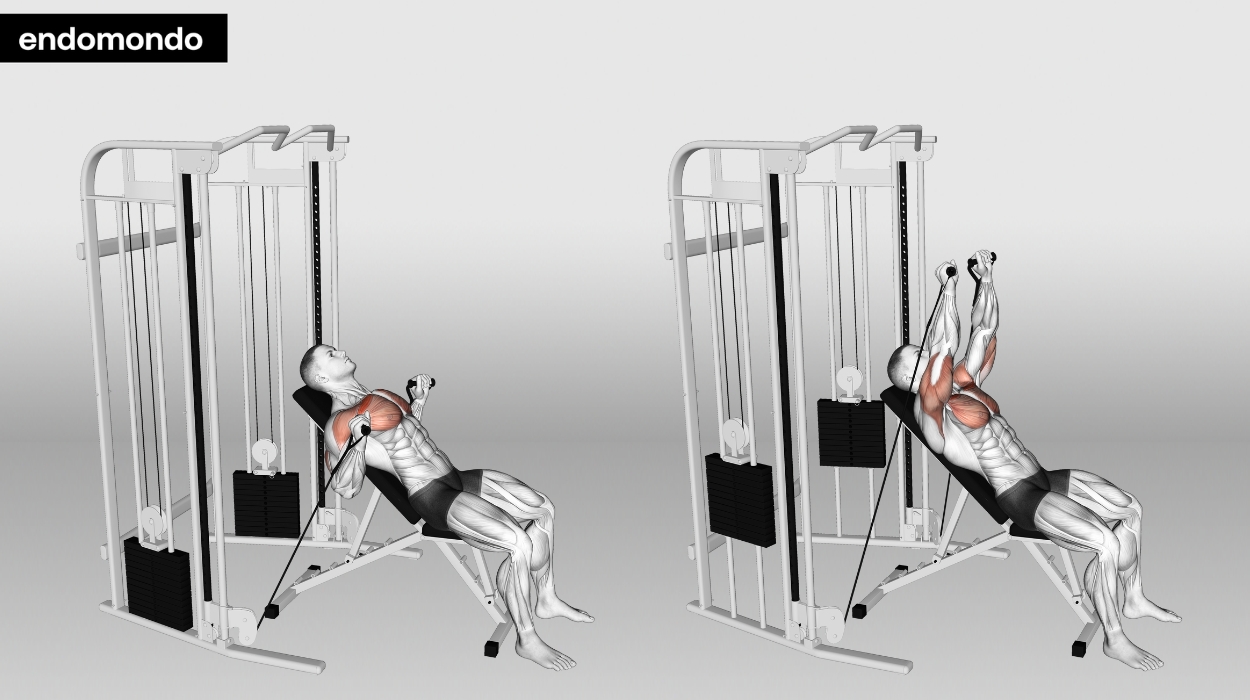
How to do:
- Set up an incline bench in front of a cable machine with the pulleys attached to the high positions.
- You will perform this exercise by lowering the cables to the floor. You will then pull the cables upward at your chest allowing your arms to straighten. This allows for great activation of the upper chest muscles.
- Lie on the bench with your back and shoulders comfortably resting against it.
- Grasp the handles attached to the cables and extend your arms upward.
- Lower the handles to your chest while keeping your elbows slightly bent, then press them back up to the starting position. This allows for great activation of the upper chest muscles.
- Repeat the movement for your desired number of reps, focusing on engaging your chest muscles.
Tips:
- Adjust the bench to an appropriate incline angle, typically around 30-45 degrees, to target the upper chest effectively and reduce strain on the shoulders.
- Maintain proper form by keeping your shoulders back and down, engaging your chest muscles throughout the movement, and controlling the weight during both the lifting and lowering phases.
- Use a weight that challenges you within the recommended rep range but still allows you to complete each repetition with the proper technique.
Optimal Sets and Reps: 3-4 sets of 8-10 reps.
Lying Incline Cable Fly
Keep that bench out; you are not done yet! Instead of performing a pressing motion as you did in the bench press, you are going to perform horizontal adduction with a big sweeping motion.
The lying incline cable fly is an exceptional cable chest exercise that primarily targets the upper pectoral muscles. Again, as you are performing a fly, the triceps will be completely taken out of the movement because the shoulder’s involvement will be minimal. The incline[5] allows your upper chest muscles to be the primary movers getting a greater portion of the stress and ultimately leading to more muscle activation.
This exercise enhances the overall chest development by sculpting and strengthening the upper chest region, giving your chest a fuller and more balanced appearance. It also promotes better muscle definition and separation. The continuous tension provided by the cables ensures optimal muscle engagement and growth.
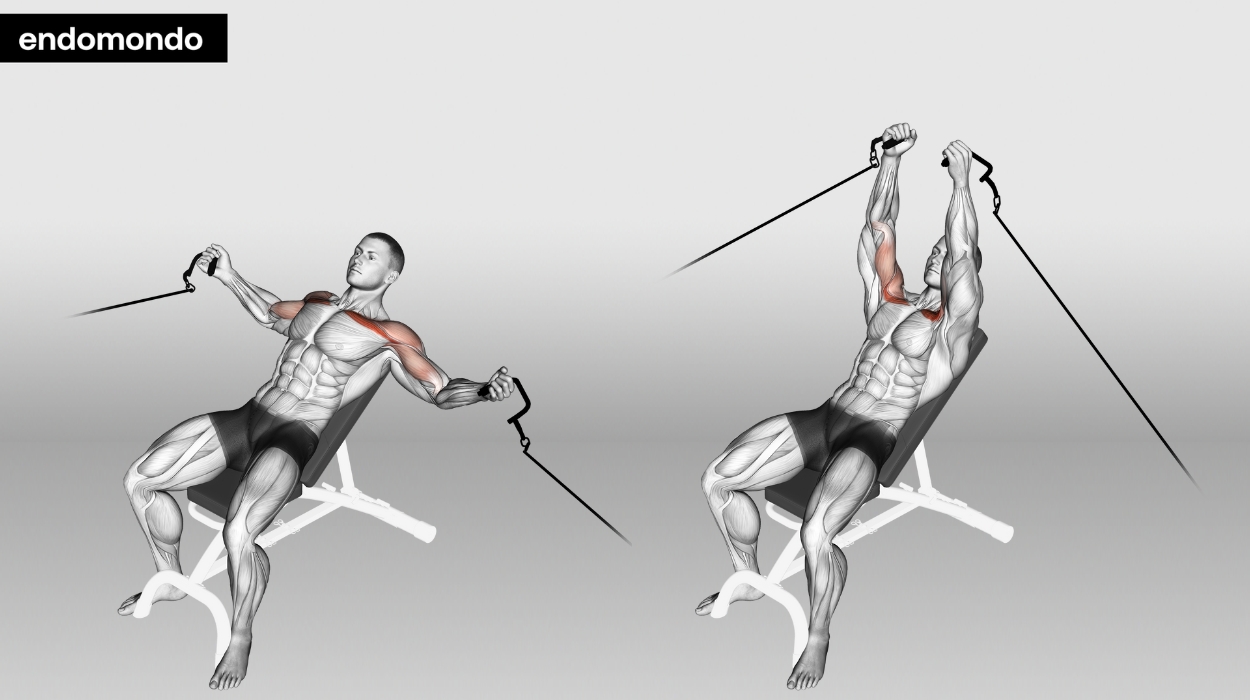
How to do:
- Set up an incline bench between two cable machines with the pulleys attached at the lowest position.
- Lie on the bench with your back and shoulders against it.
- Hold the handles attached to the cables, extending your arms above your chest.
- Lower the handles out to your sides while keeping a slight bend in your elbows.
- Squeeze your chest muscles as you bring the handles back together over your chest and repeat for your desired reps.
Tips:
- Start with the cable pulleys positioned slightly above shoulder height, and maintain a slight bend in your elbows throughout the movement to protect your joints and emphasize chest activation.
- Focus on the mind-muscle connection by squeezing your chest muscles at the peak of the contraction and controlling the cables on the way back to the starting position.
- Use a weight that allows you to perform each repetition with the proper form.
Optimal Sets and Reps: 3-4 sets of 10-12 reps.
Standing Incline Cable Fly
The standing incline cable fly is a dynamic chest exercise that primarily targets the pectoralis major muscles, providing an effective and targeted workout for your chest. This exercise is a valuable addition to any cable chest workout routine, offering several benefits for muscle development and overall strength.
By performing this exercise, you engage your chest muscles, particularly the upper and inner portions, leading to improved chest definition and shape. It also activates your front deltoids and triceps to a lesser extent, helping you achieve a balanced upper body. Additionally, the standing incline position emphasizes the stretch and contraction of the chest muscles, enhancing muscle growth and toning.
Incorporating this exercise into your cable chest workout routine can help you build a well-rounded, sculpted chest, improve your upper body strength, and enhance your overall physique. It’s an effective choice for those aiming to target and develop their chest muscles with precision and control.
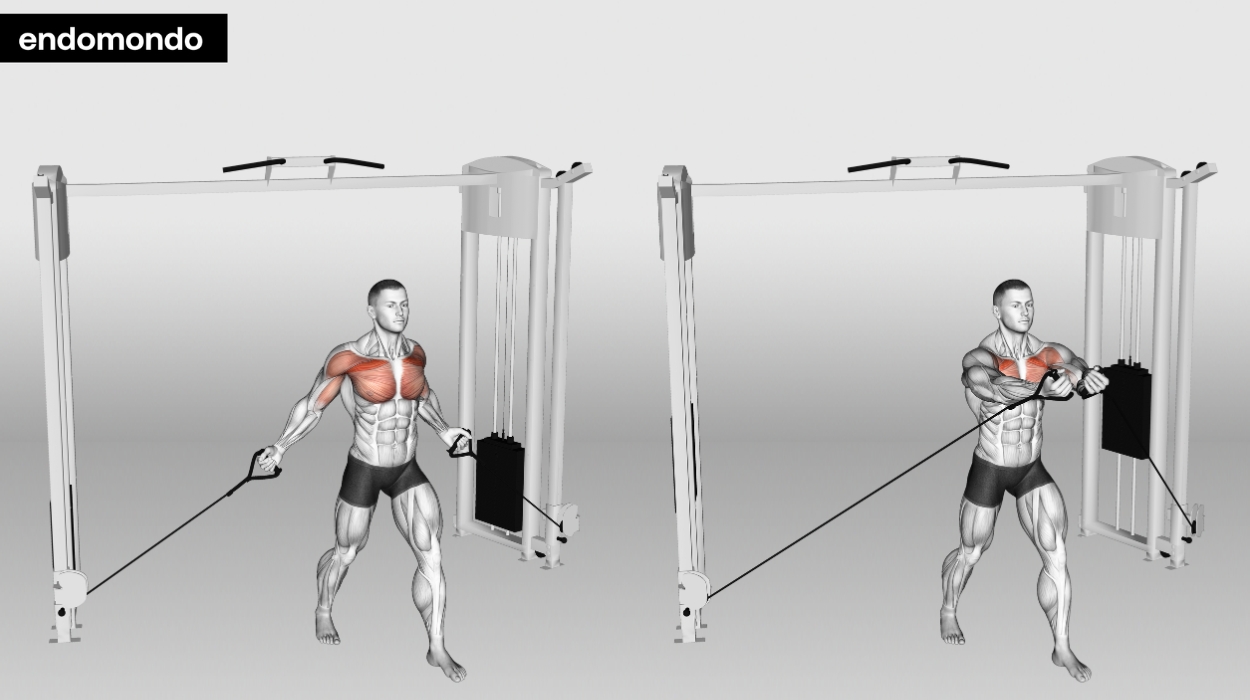
How to do:
- Set up the cable machine with the pulleys attached at the lowest position.
- Stand facing away from the bench with one foot forward for stability.
- Hold the handles attached to the cables with arms extended out to your sides.
- Pull the handles together in front of your chest, focusing on squeezing your chest muscles.
- Slowly return to the starting position and repeat for your desired reps.
Tips:
- Maintain a slight bend in your elbows and a strong core throughout the exercise to prevent excessive stress on your shoulder joints and emphasize chest activation.
- Try to end with your hands at shoulder level to optimize the movement for upper chest muscle activation.
- Focus on coming all the way up and inward for maximal activation.
Optimal Sets and Reps: 3-4 sets of 10-12 reps.
Benefits Of Chest Exercises With Cables
The cable machine is a similar piece of equipment to free weight exercises but allows for greater muscle isolation. See below for the additional benefits the cable machine provides leading to improved upper body strengthening.
Constant Tension
The biggest disadvantage of free weights is that they do not provide a consistent force on the muscle. When lifting free weights, the actual load placed on the muscle varies depending on the range of motion being attained.
For example, when you perform a barbell curl, the most difficult part of the lift is when your elbow is at a 90-degree angle with the weight straight out in front of your body. This is because the weight is far from the body and places the greatest torque.
However, with a cable pulley machine, the resistance will remain the same no matter its position through the movement. This is because the force comes from a single point and will pull in that one direction with close to the same amount of force at every angle.[6]
Hit Many Angles
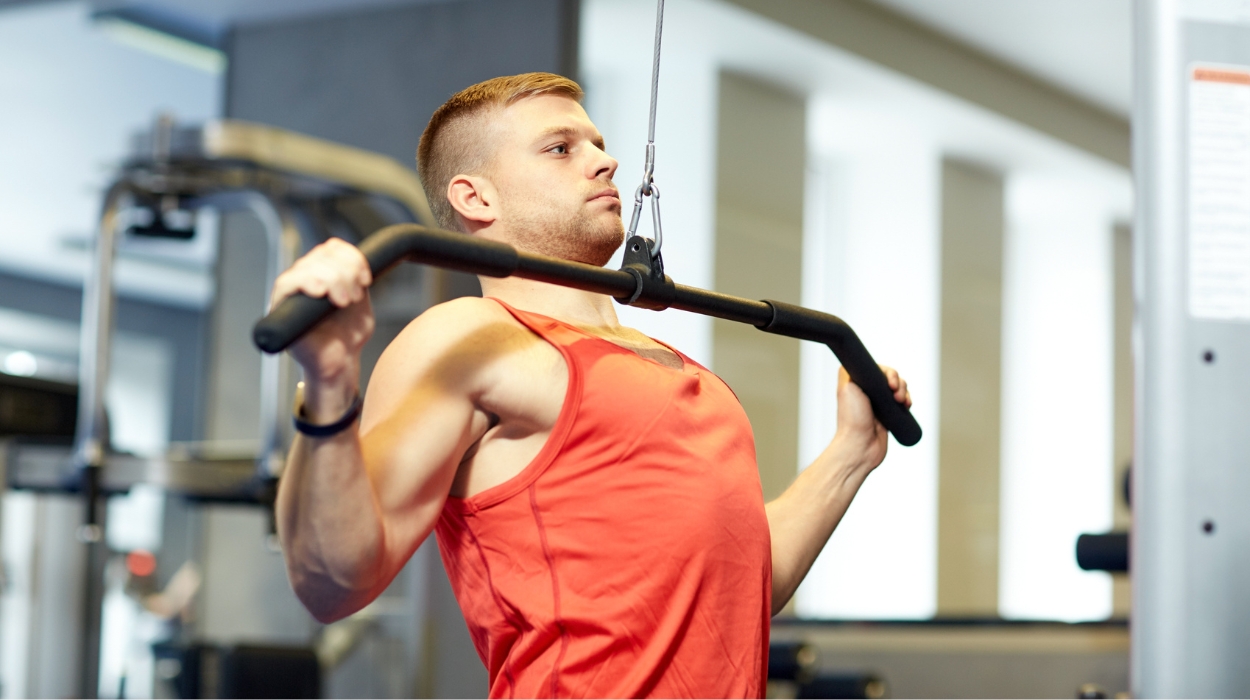
This benefit is due to raising and lowering the force to just about any height. When comparing to free weights, you see that there’s only one line of force, straight down which severely limits the exercises you can perform and the angle at which you can hit muscles.
Being able to achieve many angles in a movement is highly beneficial for muscle hypertrophy as researchers have recently discovered that a muscle does not grow uniformly.[7] Rather, the part of a muscle that sees more stress will experience more growth. Therefore, hitting it from various angles will optimize muscle growth.
Easy To Switch Exercises
If you are in a rush, doing your workout on a cable pulley machine can easily save you time. To change exercises, all you must do is change the cable attachment as well as the height of the pulley. This allows you to jump from one exercise to the next extremely easily.
Or, you can even perform compound sets or supersets. Either way, a cable machine takes away the obnoxious necessity of needing to re-rack weights.
Tips For Cable Chest Exercises
Using cable machines is relatively simple, however, there are some steps you can take to optimize your cable chest workout.
Use Slow, Controlled Movements
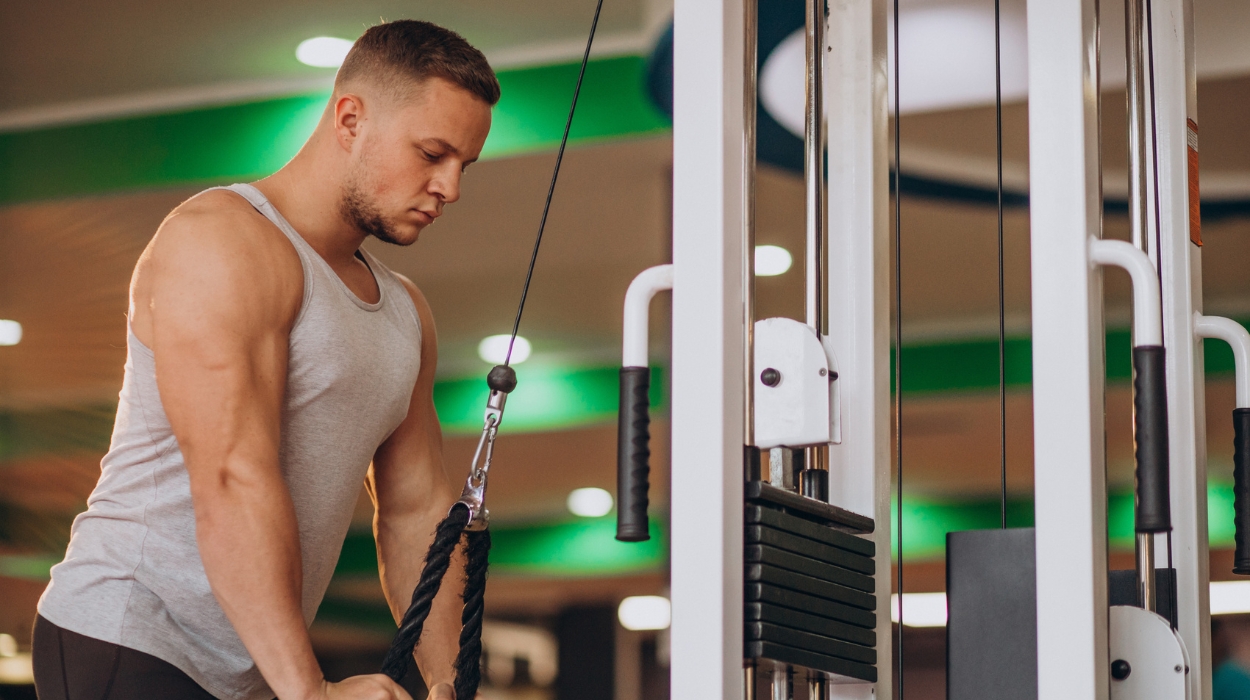
When performing the movements, be sure you pull on the cable with slow, controlled movements. This ensures that the load will move smoothly with no jerky movements. When lifters try to go too fast, slack can build up in the cable, which results in load jerking throughout the rep.
Ultimately, this creates a set that is uneven and uncomfortable. Luckily, you can simply use slow, controlled reps to prevent it from happening.
Perform Full Range Of Motion
One of the benefits of a cable chest workout is the ability to go through a large range of motion. Therefore, it makes sense to use it! We say this to drive home the point of pushing yourself on each rep, especially at the end. Try to perform each rep to the full ability of motion
Conclusion
Try our cable chest workout to improve muscle activation and increase muscle mass in your chest and upper body. Add them into your program to build your cable chest workout aiming to train both your upper and lower chest with at least one cable exercise every week.
For guidance on a good workout split consider using this five-day workout routine or using this three-day guide. It is important to continue lifting focusing on progressive overload and intensity to see results in the future.
Frequently Asked Questions
You should train your chest twice a week with two to three days of rest in between.
You will progress just like any other exercise. Use progressive overload by adding weight.
Yes! Cables allow you to hit the chest from multiple angles with a larger range of motion than free weights.
Resources
- Solari, F. and Burns, B. (2023). Anatomy, Thorax, Pectoralis Major Major. [online] Nih.gov. Available at: https://www.ncbi.nlm.nih.gov/books/NBK525991/.
- Trebs, A.A., Brandenburg, J.P. and Pitney, W.A. (2010). An Electromyography Analysis of 3 Muscles Surrounding the Shoulder Joint During the Performance of a Chest Press Exercise at Several Angles. PubMed, [online] 24(7), pp.1925–1930. doi:https://doi.org/10.1519/jsc.0b013e3181ddfae7.
- Schöenfeld, B.J. and Contreras, B. (2016). Attentional Focus for Maximizing Muscle Development. Strength and Conditioning Journal, [online] 38(1), pp.27–29. doi:https://doi.org/10.1519/ssc.0000000000000190.
- Coratella, G., Tornatore, G., Longo, S., Esposito, F. and Emiliano Cè (2019). Specific prime movers’ excitation during free-weight bench press variations and chest press machine in competitive bodybuilders. European Journal of Sport Science, [online] 20(5), pp.571–579. doi:https://doi.org/10.1080/17461391.2019.1655101.
- Lauver, J.D., Cayot, T.E. and Scheuermann, B.W. (2015). Influence of bench angle on upper extremity muscular activation during bench press exercise. European Journal of Sport Science, [online] 16(3), pp.309–316. doi:https://doi.org/10.1080/17461391.2015.1022605.
- João Pedro Nunes, Jeferson Lucas Jacinto, Ribeiro, A.S., Mayhew, J.L., Nakamura, M., Danila M.G. Capel, Santos, L.R., Leandro dos Santos, Edílson Serpeloni Cyrino and Andreo Fernando Aguiar (2020). Placing Greater Torque at Shorter or Longer Muscle Lengths? Effects of Cable vs. Barbell Preacher Curl Training on Muscular Strength and Hypertrophy in Young Adults. International Journal of Environmental Research and Public Health, [online] 17(16), pp.5859–5859. doi:https://doi.org/10.3390/ijerph17165859.
- Costa, B., Witalo Kassiano, João Pedro Nunes, Kunevaliki, G., Pâmela Castro-E-Souza, André Luíz Félix Rodacki, Cyrino, L.T., Edílson Serpeloni Cyrino and Leonardo (2021). Does Performing Different Resistance Exercises for the Same Muscle Group Induce Non-homogeneous Hypertrophy? International Journal of Sports Medicine, [online] 42(09), pp.803–811. doi:https://doi.org/10.1055/a-1308-3674.




